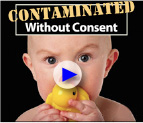Contact: Coming Clean, (802) 251-0203, info@comingcleaninc.org
December 10, 2009
Toxic Chemicals in Bodies Report from Centers for Disease Control
Environmental Health Advocates Respond
(San Francisco) The National Health and Nutrition Examination Survey (NHANES) released today by the Centers for Disease Control (CDC) is on the right track with a focus on testing people’s bodies for chemical contamination, say physicians, scientists, and environmental health advocates working on chemical exposure issues.
According to Pamela K. Miller, executive director of Alaska Community Action on Toxics, “While we are very relieved the CDC stepping up its focus on chemical exposure with this important monitoring of toxics in people’s bodies, we would also like to see them collecting data to reflect geographic location in order to assess regional exposure patterns.” In Alaska, Persistent Organic Pollutants (POPs) – chemicals that can take many years to break down – drift north on wind and ocean currents. Indigenous peoples of the Arctic have some of the highest exposures on earth. Alaska has one of the highest rates of birth defects in the nation. Some scientists believe that the gender imbalance of more girls being born than boys in the Arctic is due in part to exposure to endocrine disrupting chemicals Being used in the South; In the US, the southern 48 states are sending North a host of endocrine disrupting chemicals not yet restricted by the Stockholm Convention.
Sharyle Patton, program director at Commonweal, says, “CDC should make individual results available to those they have tested. As the European Union begins its pilot biomonitoring study, it will be making plans to do just this, given EU legal support for the right to know. In the interests of transparency and access, and as leaders in national biomonitoring programs, surely we can do the same.
Margaret Reeves, PhD, senior scientist with Pesticide Action Network North America, who works with farmworker and rural communities says, “It is necessary for CDC to link time of year of specimen collection and the occupation of the participant to see patterns with pesticide and other exposures.”
Peter Orris, MD, MPH, Professor and Chief of Service, Environmental and Occupational Medicine, University of Illinois at Chicago Medical Center welcomes the report as important for monitoring chemicals: “I would hope that CDC will continue to collect information and will also look at intergenerational comparisons to help protect women of child bearing age from those chemicals that may damage the developing fetus.”
“Biomonitoring studies such as the ones conducted by the CDC provide direct evidence that people are being exposed to harmful chemicals without their knowledge, much less their consent. This is critical information for decision makers who can then craft policy instruments that will reduce or prevent exposures and also have a way to track whether those instruments are working," said Davis Baltz, M.S., a Senior Associate with Commonweal.
Available for Interviews
- Pamela K. Miller, executive director, Alaska Community Action on Toxics (ACAT) 907-222-7714. Pam can address the issue of POPs chemicals and chemical contamination among the Indigenous people of the Arctic and in Alaska.
- Sharyle Patton, Director, Health and Environment Program at Commonweal Institute. 415-868-0970. Sharyle can put reporters in touch with various individuals who have been biomonitored and have found toxic chemicals in their bodies.
- Peter Orris, MD, MPH, Professor and Chief of Service, Environmental and Occupational Medicine, University of Illinois at Chicago Medical Center. Office, 312-996-5804, Direct 312-413-0105. Dr Orris can discuss biomonitoring and health effects linked to chemical exposure.
- Margaret Reeves, PhD, Ecologist and Senior Scientist, Pesticide Action Network North America, 415-981-1771. Dr. Reeves can discuss biomonitoring of farmworkers and rural residents near pesticide application areas.
- Davis Baltz, M.S., Senior Associate with Commonweal Institute, 510-848-2714. Davis can talk about national and international policy on protection from chemicals.
Resources
- Is It In Us Biomonitoring Study
- Toxic Chemicals in Doctors and Nurses Biomonitoring Report
- Earliest Exposures Biomonitoring of Pregnant Women Report
- Environmental Health News article on Biomonitoring
# # #




